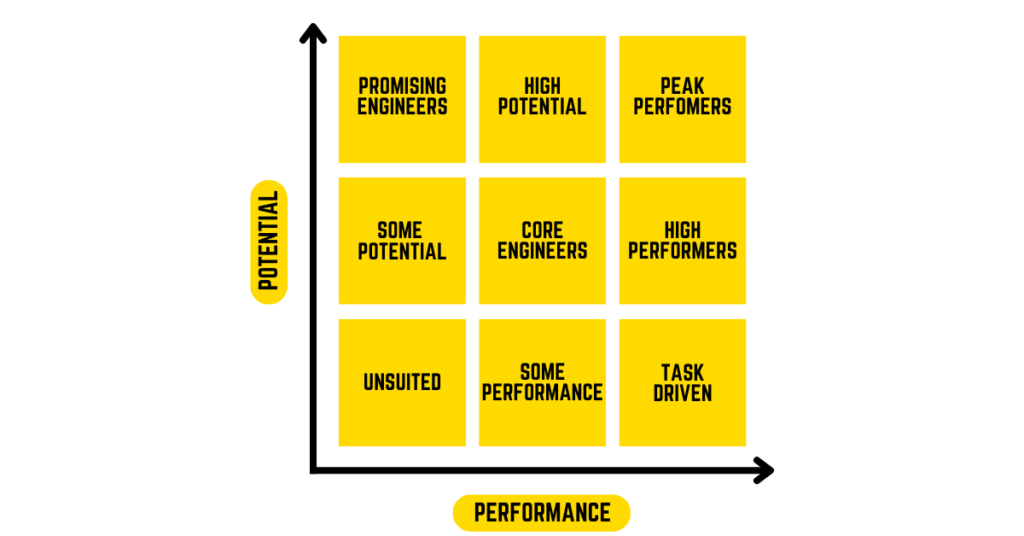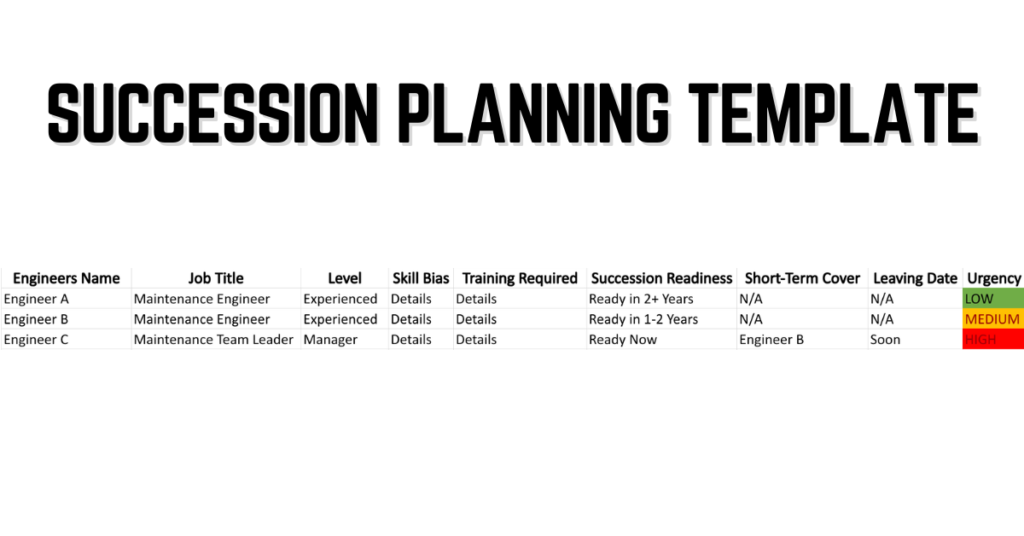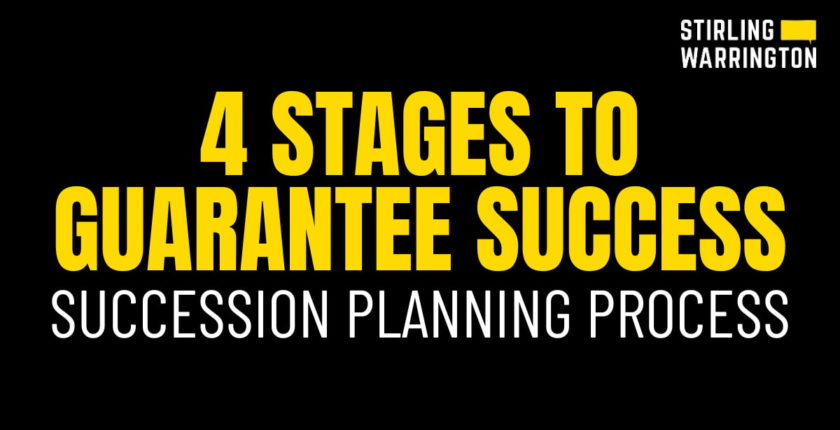Succession Planning Process: The 4 Stages to Guarantee Success
Following on from the ‘What is Succession Planning’ blog, I want to talk about the actual process and steps that make up the plan with a detailed explanation of each stage.
Making sure that each stage is carried out correctly is so important! I think so many companies forget this, and this leads to them overlooking succession planning entirely. This is a big issue as it results in companies losing talent to retirement and natural attrition.
Succession planning can only lead to positive things for companies, and with costs only increasing it seems that it is more important now than ever!
So, what are the 4 steps to guarantee success when succession planning?
Stage 1: Assessment
Stage 1 in the succession planning process is always so important as it allows companies to evaluate 3 key aspects to determine their position:
Review Your Company’s Goals
Start by reviewing your company’s long-term goals. Where do you want the business to be and by when? Understanding this will help you set a realistic time frame for implementing your succession plan.
Succession planning typically takes between 1–8 months, depending on the role and level of preparation needed.
When reviewing your goals, consider:
- What are the long-term goals for the business?
- How achievable are the goals in the given timeframe?
- Are you in a position to implement a succession plan?
Evaluate Current Skill Sets & Roles
Evaluating the current skill sets and roles within the business shows you two things.
- What you’ve got.
- What you’re missing.
Once you know this, you can figure out where you can promote, what you need to recruit and who you need to train.
Ask yourself questions like:
- Who hasn’t had training recently?
- What skills are required to maintain our machinery?
- What skills do we need for the future?
When assessing engineers, I like to look at the whole picture. Comparing their potential with performance is the best way to understand this.
Take a look at the grid below.

Understand The Current Team Dynamics
Now you’ll want to determine which of your employees want to take a step up. This next step is vital!
Some engineers will want this, and some won’t. Having meetings will help you assess the team and prepare for the next step.
So, consider these:
- What skills does the engineer already have?
- Do they want a promotion?
- Are they planning on retiring OR unhappy and considering leaving?
Understanding your employee’s career path is important, as we all know that people can come and go – some more often than others. So, getting this insight can help prepare sooner. For this stage, we recommend creating an organisational chart to show where engineers can go!
Stage 2: Creation
The creation stage is where you can truly map out your succession plan. Taking everything you’ve learnt from the assessment stage to help put a plan in place.
I believe that the creation stage can be broken down into 3 elements:
Create A Succession Plan
Now that you’ve made your assessment, it’s time to actually create something!
One of the first things you’ll focus on is creating a document that will form the backbone of your succession plan.
Something like the one below.

With this you’ll monitor employee progress and the overall situation. Focus on succession readiness, urgency, and business impact.
And always have this in the back of your mind:
- Aligning your succession plan with the company’s goals.
- Being realistic with deadlines.
Create A Training Plan
Next, you’ll create a training plan. Ideally, you’ll want to create two training plans:
One for The Job
Training plans for the jobs that you are succession planning for is essential for engineers to learn and shape their practices to your company’s likening. Key aspects to think about at this point are:
- The styles of training (practical or verbal).
- Duration of the training programmes and if they align with your deadlines.
One for Each Engineer
Tailoring training programmes to your current engineers’ needs, skill level, and ability is vital.
When creating training plans remember to:
- Find the suitable level of training plans for all your engineers.
- Make sure that your engineers are comfortable with the training plans.
At a minimum, you should create a training plan for the job. That way you’ve got something. I’ll talk about best practices for implementing training for your business later in the blog.
Recruitment Plan
Although I think it’s important to succession plan for every role, you might not have all the skills you need. So, these need to be recruited for. Because of this, you’ll then need to create a recruitment plan.
Key tasks and things to remember when recruitment planning are:
- Knowing who and what you want, and if they fulfill the requirements.
- Tailoring job descriptions to what you exactly need.
- Accommodate for natural growth.
Stage 3: Implementation
You’ve made your assessment and got your plans sorted. Now you can move onto the next stage: Implementation.
Many think that this stage is simple, but there are a couple of things you must do first.
Recap With The Team
You should’ve already had a chat with your employees at an earlier stage. But it’s important here to check in with them and ensure that they hold the same intentions as before!
You can inform your employees about the plan of action when they begin their journey.
Before starting make sure that:
- Engineers are still on board with the succession plan process
- No significant changes have occurred within your company between now and the creation phase, which could affect the succession plan.
Prepare For Training Sessions / Job Shadowing
You would have booked training and job shadowing sessions as part of your plan. But if not, go back and add that in! (before implementing this you’ll need to make sure those engineers have the time to do so)
This will vary depending on what resources you have. Some companies can arrange cover for that engineer. Others may implement overtime to ensure everything gets done. Either way, you’ll need to consider:
- Who can take over some of the tasks whilst this engineer is training/shadowing?
- Can some of the tasks on that day be rescheduled?
Sometimes, job shadowing might need to happen organically (like on the shop floor when a machine breaks). But it’s always worth trying to be structured with this section.

Wanting to know more details about what to expect in your maintenance engineer interview? You can take a look at our other blog where we walk you through a mock interview.
Start Recruitment
There will be certain roles that you’ll have to recruit for. As you’ve been able to plan, you have a rare opportunity to recruit proactively rather than reactively. So, it should make this stage of the succession planning process feel less of a firefight.
But, interviewing and selecting the right engineer to bring on board is not an easy task, so:
- Don’t rush the hiring process
- Make sure you find the engineer that aligns with the company’s vision.
Stage 4: Monitoring
You’ve trained up your engineers, you’ve hired for the gaps, and everything’s ticking along. You’d think that would be the end to succession planning.
Not quite.
The final stage is monitoring the succession planning process. You want to make sure that nothing is going off track, so you should:
Check-in With Engineers
Regular catchups with your engineers are a great way to monitor their progression. But when you are speaking with senior engineers, set time aside to also discuss the training engineer’s succession readiness. That way, you get multiple perspectives.
These meetings will let you collect feedback, helping to shape the succession planning process as it continues. When checking in remember to ask:
- Are you happy with the pace of training?
- What would better support you?
- Would you change anything about your plan or career?
Review Progress Against The Business Goals
A successful succession plan will help you meet your company’s goals. So, it’s important to check it’s achieving the intended outcomes.
- What progress has been made?
- If the succession plan hasn’t served its purpose, have you given it enough time?
5 Mistakes To Avoid When Succession Planning:
The succession planning process does vary from business to business. But quite a few make the same mistakes. So, you should be wary of:
- Having no set vision in place.
- Picking favourites (employees) – Choose those who are the most dedicated and hard-working.
- Rushing and not giving the process enough time.
- Not continuously monitoring and letting things slip.
- Not adapting some of the training plans to engineers.
If you avoid these 5 common mistakes when succession planning, you’ll succeed.
The Succession Planning Process Summarised
Succession planning is a difficult task, as there are a lot of elements involved in the process.
However, not succession planning is risky for companies. And not having a process will cause a headache. So, implementing both parts will take your company to new levels.
Following this detailed step-by-step guide will give you the confidence to succeed in the planning process. The most important thing to remember is to trust the process, as the final product is so worth it!
How We Can Help You In The Succession Planning Process
We understand the importance of succession planning. And can come in to help structure your team and find the gaps in your company.
Our team of recruiters will assist you in the succession planning process, from the planning to the engineer’s first day!
We can make the process easier for you. By us taking half the workload (the recruitment part), you just focus on internal management and training – or just your day job! You’ll have an expert pair of hands that will:
- Proactively contact passive candidates on the market (with our database of 10,000 engineers and via socials)
- Engage engineers and screen their suitability to your business.
- Sell your company, either via traditional means or marketing (check out our RPO to see more about how recruitment marketing can benefit your business).
These are just 3 things that our expert engineering recruitment consultants do. If you’d like to know more, reach out to us today!

